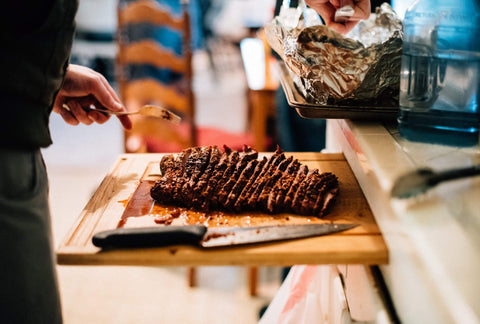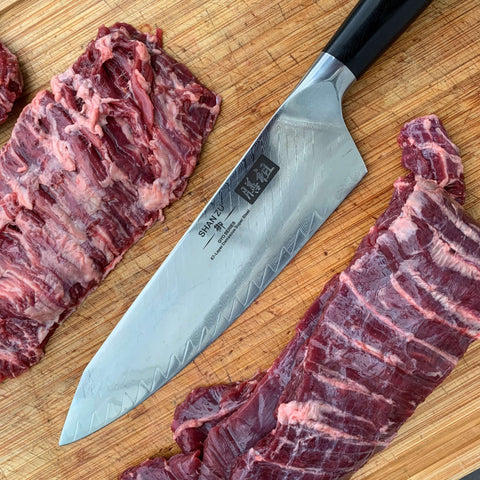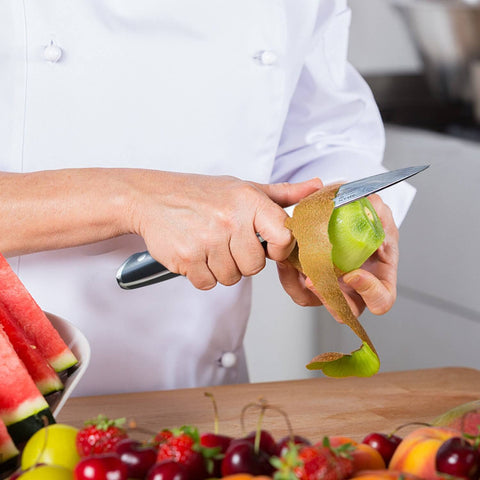
Brisket is one of the benchmarks of barbeque. Making a brisket is a lot of work that can easily take around four hours to a whole day. Undoubtedly it is a hard job, but the juicy result is worth investing your time in. However, all the hard work can go to waste if you fail to cut brisket right.
If you're looking for easy-to-follow techniques on how to cut brisket, you're at the right place. The article will take you through the crucial steps to help you cut a brisket perfectly while increasing your knowledge to do the job better.
Without further ado, let's get started!
Why Is It Essential To Slice A Brisket Properly?When preparing a brisket, many people think cooking is the only important part ignoring the importance of cutting it; unfortunately, they have a chewy brisket.
A property cut is a deciding factor between tough and tender brisket. If you don't cut a brisket properly, your meat will turn chewy no matter what you do.
What Do You Need To Know About Slicing Briskets?- · Fat Content Of Brisket
The juice and flavor of a brisket come from the marbling, which is also a factor in checking the brisket's quality. To increase the level of juiciness and overall flavor, you can leave around one inch of fat on the outside of the brisket before cooking it. Use a sharp knife to trim the excess fat while the brisket is still cold.
- · Brisket Point
The brisket includes two main muscles, one of which is the point. It is the other half of a whole brisket called "full packer." The brisket point is thicker and looks like a lump of traditional meat joined tapered at one end, which is why it is called "Point." However, it's thicker but is smaller in dimensions. It adds extra flavor to the brisket while yielding less meat.
When purchasing a brisket, it's up to you if you want both muscles separately or want to keep it a whole. Brisket point has more connective tissue and fat than brisket flat cut. Therefore the point is mainly shredded than sliced due to its higher fat content. This way, it becomes easy to chew while leaving beautiful texture on the surface, especially in the case of fattier cuts.
The other name for brisket point is "Deckle." It is the fat, thick and muscular layer attached to the ribcage of the brisket that is "Point" itself.
- · The Fat Cap
Brisket comes from the chest part of the animal where the side facing towards the skin is covered with a thick layer of fat. This fat is commonly known as a fat cap. It is the side that is completely covered with fat. Fat cap is mostly around 1 inch thick, where the exact thickness of the layer is dependent on the health of the individual animal and how it was butchered.
Choosing the Best Brisket for Smoking· Grades of Beef
To begin with…
There are generally two qualities of brisket to choose from "Choice" and "Select" depending on various factors like the quality of butcher or supermarket. The choice is a higher quality of brisket than select. The visible difference between both is the marbling of fat, which gives flavor to the brisket. Hence it is recommended for the higher quality brisket, ie, choice. Although the choice is slightly expensive than selecting the result is worth investing.
· Size MatterThe next thing you need to be careful about when purchasing a brisket is the size. Generally, a brisket is cut as small as two pounds or as large as 14 pounds. But in some cases, you might not need a big serving.To avoid purchasing more than you need to follow the universal rule of purchasing half-pound brisket per person.
Nice Looking Fat You've Got There!
Because every cut is different, looking at the meat carefully is recommended to ensure getting a good package. Here's how you need to check the fat content and marbling of the brisket.
Look for the uniformed thickness throughout the flat edge at the bottom.
Carefully estimate the pointcut to check if the fat is evenly marbled. It is essential because an uneven brisket fat gets dry in spots.
A Quick Note on PriceNobody can tell the exact price of a good quality brisket because it varies on the time of the year, cost of the gas/feed, a place where you live, etc. however, it is estimated that brisket should cost you between $2 to $22 per pound.
What Do You Need Before You Slice?- A well-rested brisket
- A brisket slicing knife
- Large butcher's block/Cutting Board
- Trash Bowl
- Patience

A sharp knife with a long blade is required to generate smooth and even cutting in the most challenging piece of flesh. It is not required to purchase a more expensive knife; a 12-inch sharp knife will work.
When using a knife in the kitchen, it's common practice to curl the knuckles of your guide hand to avoid accidentally cutting your fingers. In the case of brisket, things are different. When slicing brisket, you'll need to use your guiding hand to help shape and preserve the meat. Always be aware of where your fingers are at all times and exercise caution.
Now that you know all the necessary detail about brisket, let's unfold the ultimate answer to the most problematic question, "How to cut brisket."
Trimming a Raw Brisket· Examine the brisket for redness and moisture.
Coming to the central part of handling the brisket, understanding your brisket is the essential and most crucial step. When purchasing your brisket, try to grab a flat cut for a slice of leaner meat that's better for slicing or a pointcut for a fattier, more flavorful cut that's best for shredding.
Make sure the brisket has a nice red color because your aim here is to enjoy a little damp and juicy brisket when cooking.
· Cut the fat cap off in sections with a sharp slicing knife.
In case you don't know, the fat cap is the fat layer that remains against the point side of the meat. Some people prefer to remove it altogether, while some prefer to leave around half to one inch of the fat layer on the meat.
To cut out the fat cap completely, divide your meat into sections. Slip your knife under the fat, and slide it back and forth until the section comes off.
To slightly remove the fat cap, only cut the upper part of the fat in the thicket sections. It's recommended to leave fast when you're smoking the brisket.
· Trim off the small pieces of fat on the underside of a flat cut.
The flat cut has a lot of fat on one side and smaller fat chunks on the other. This can also be found in a whole brisket. Trim away any little bits of fat that may be a barrier between the meat and the flavor.
Place the point of your knife under the fat's edge. Push the knife beneath it, then see-saw back and forth while sliding the knife outward to slice it off.
· Cut down the fat vein between the point and flat cut on a whole brisket.
If you get a whole packet, which includes the entire brisket, there will be a significant fat layer between the two pieces. It is not required to remove the layer entirely, but removing a portion of the fat is vital.
To do so, start with the outer edge of the fat vein and aim to cut small chunks of the fat. Cut the fat down to the point where the meat can be seen. This will allow you to raise a piece of meat and season it in the middle.
Finding the Grain of the Cooked Brisket· Examine the meat to find the grain on a flat or point cut.
Place the brisket on a chopping board to examine it. The grain is the pattern in which the muscle strands travel through the flesh. It's like a long string of rubber bands. On the flesh, these lines may be seen.
· Check for the grain in 2 directions with a whole brisket.The grain will flow in various directions on the flat and point cut if the complete packer is used. It's OK to separate them as soon as you're done cooking deal with the situation appropriately.
If not, cut along the flat cut against the grain until you reach the point cut. After that, raise and slice both pieces apart to separate them.
Another alternative is to cut the flat cut up to deal with the situation properly against the grain. Then raise and spin the meat to a 90-degree angle, slicing both slices of meat at a 45-degree angle against the grain.
· Turn the meat, so your knife is perpendicular to the grain.To enjoy tender bites of meat, you must cut against the grain. Once you successfully find the grain set your knife in a position that you slice against the grain.
To avoid making your brisket tough to chew, turn, and cut the rubber bands on it. In this way, the brisket will form small pieces that will be easier to deal with when eating.
Slicing the Cooked Brisket· Rest the cooked brisket for 20 minutes to 24 hours before slicing it.
Keep in mind letting your meat rest for at least 20-25 minutes after you're done cooking is the essential part. It helps make the brisket juicy.
If you're looking to achieve skinny slices of meat, it is better to wait for at least 24 hours, so the brisket is completely cold while you cut it.
· Use a long serrated knife for slicing the brisket.Although it's unnecessary to go for a serrated knife (the one with points along the edges), it is recommended to use once for best results. The minor points along the edges of the knife will help you slice through the brisket better.
Look for a knife that is 8 to 10 (20 to 25 cm) long. With such a knife, it will be easier to slice the brisket at once.
· Use short strokes to go across your brisket against the grain.
It's not possible to slice across a slice in one store, so don't do it. Instead, go on a see-saw ride and work your way from top to bottom.
Start at one end and work your way across an angle to cut off a slice if your meat is comprehensive.
· You can also trim off extra fat as you go if you'd like.
Aim for slices that are about a pencil-width thick.
If the brisket appears challenging, go thinner, but this measurement is an excellent starting point. Try a little thicker cut if it's falling apart.
COMMON Q&A· How to Cut a Whole Brisket?
- Cut the meat in half to separate the flat and point.
- Now trim the small pieces of the flat underside of the flat cut to avoid losing the flavor.
- Then cut off the tips of the brisket to avoid harming the overall look of the brisket.
- Now place your knife in a position to cut the grain of the meat at 90 degrees.
- In the final step, slice your brisket with a sharp knife.
· How to Cut Brisket In Half?
To cut brisket in half, we recommend using a boning knife. A boning knife makes it easy to cut the fat layer between the flat and the tip. Follow the fat cap slowly, so you don't nick the flat excessively. This is the most significant sacrifice you'll make during the procedure.
· How To Slice the Flat?- Start by cutting your brisket in half. This will help you separate the flat from the point.
- Now slice the brisket flat against the grain.
- When done with that, move your brisket to 90 degrees to slice in half
- Now slice the brisket point against the grain, and you're done.
- Start by cutting your brisket in half. This will help you separate the flat from the point.
- Now slice the brisket point against the grain.
- When done with that, move your brisket to 90 degrees to slice in half
- Now slice the brisket flat against the grain, and you're done.
Whether you serve the brisket flat shredded or sliced, around a half lb. per person will be enough for the main meal unless they are a big eater. Fit and hungry teens and athletes should get up to 1lb per person.
If shredding and putting the meat into a sandwich, then 4oz. It will be enough for most, and around 6-8oz will do for the Hungarian among you.





Comments (0)
There are no comments for this article. Be the first to leave a message!